Blog.
The Future of Technology:
Trends to Watch
Changing Payroll Providers Midyear in New York: How to Switch Without Disrupting Paychecks

Changing Payroll Providers Midyear in New York: How to Switch Without Disrupting Paychecks
Switching payroll providers midyear in New York with no delays. Learn timing, steps, and compliance for changing payroll hours safely this year.
Prevailing Wage Certified Payroll Form in New York: 2025 Filing Requirements Explained
Understand New York City law and NY State transparency, pay range posting rules, coverage, penalties,
How Much Is Paid Family Leave in New York? Updated Rates and Rules for 2025
Understand New York City law and NY State transparency, pay range posting rules, coverage, penalties,
Full-Service Payroll Companies in New York: Stress-Free Payroll From Check to Compliance
Understand New York City law and NY State transparency, pay range posting rules, coverage, penalties,
Payroll Companies in New York: The Best Services for Stress-Free Compliance and Accuracy
Understand New York City law and NY State transparency, pay range posting rules, coverage, penalties,
Table of Contents
- Should you switch payroll providers in New York now?
- Our services at Premier Payroll NY for clean cutovers
- Pricing to budget before you switch
- Must-have New York features on day one
- Implementation timeline for a no-gap cutover
- Proof and ROI after you change
- Why Premier Payroll NY is the safer switch
- Get your quote and switch date
- Work with Premier Payroll NY before your summary
- In summary…
- FAQs
Should you switch payroll providers in New York now?
Switching midyear in New York saves money and stress when real pain shows up in your current run. You make the call by weighing cost, error rates, and the support pattern you see in tickets and callbacks. You also check the calendar for quarter closes, bonus runs, and union or seasonal cycles that increase risk. You pull payroll information, ask advisors for a second look, and write the payroll questions your next provider must answer. With that prep, a midyear switch stops losses while you still have months left to benefit from the new stack.
Our services at Premier Payroll NY for clean cutovers
Our services at Premier Payroll NY help teams run disciplined, audit-ready migrations that keep every paycheck on time. We align your payroll migration checklist with New York rules, map pay codes, and prove totals with one clean parallel. For scope and tools, see NY Payroll Experts, our Integrated Payroll System, the side-by-side Compare page, and our industry fit for Restaurant and Hospitality Payroll. These services shorten time to value while your workforce stays paid and informed.
Cost, errors, and support gaps that justify a midyear change
Escalating per-employee fees and surprise add-ons create a drag that compounds every run. Repeated tax notices, late deposits, or misapplied credits reveal deeper process flaws you should not carry into Q4. Slow or scripted support that loops you through chat and email without resolution burns payroll hours and morale. If audits show manual patches for basics like PFL caps or Yonkers local, your team spends time fixing what software should handle. When you tally that waste against switching costs, a midyear change often pays for itself before year-end.
Red flags that mean you should wait a pay cycle
You should wait one cycle if key year-to-date files remain incomplete or the banking team has not cleared ACH limits. Delay one run if large bonus payouts, retro pay, or union rate changes hit this week. Pause if your current provider owes you amended returns or if a tax jurisdiction change goes live in the next few days. Hold if open garnishment changes or child support orders have not yet received agency confirmation. A short, intentional wait to finish these tasks protects the launch and prevents rework.
Pricing to budget before you switch
A smart budget covers setup, migration, subscriptions, add-ons, and exit terms so you avoid surprise spend. You price the platform, the services you need in month one, and the integrations that shorten cycles. You push for concessions on implementation and insist on written caps on hourly work. You read the contract for renewal dates and auto-increases so you do not relive the same pain next year. With a complete view, you sign a deal that matches your headcount and New York footprint.
Pricing structure, modules, and payroll options
Clarify the pricing structure across modules so you know which payroll options you will actually use. List core payroll processing capabilities, then add time, benefits, and HR modules only if they meet payroll service needs. Ask for a calculator that shows total cost at your workforce size and pay frequency. Compare quotes from each payroll vendor or payroll service provider using the same usage profile. Keep the website quote, the contract, and the add-on menu in one file so advisors can review.
Setup and data migration fees you can negotiate
Vendors often quote separate fees for implementation, data mapping, and historical imports. You can reduce these charges by delivering clean templates, naming a single point person, and agreeing to a fixed scope. Many providers waive partial fees when you commit to a longer initial term or bundle time, benefits, or HR workflows. You can swap hourly discovery for a flat-rate package with defined deliverables and internal deadlines. Document the price, the artifacts due, and the acceptance criteria so both teams close the phase on time.
Monthly payroll, add-ons, and hidden surcharges
Base pricing rarely includes local tax handling, garnishment services, or multistate filings. Time, benefits administration, workers’ comp, and carrier feeds often sit in add-on menus that inflate the total. Look out for delivery fees on W-2s, check stock, off-cycle runs, and same-day wires. Review charges for agency notice response, amended returns, and year-end reprints so you budget the full year. Ask for a single statement that lists every recurring fee to stop silent creep.
Contract terms, exits, and renewal dates
Your contract sets price safety long after the sales call ends. Check for auto-renewal and the notice window so you do not miss the date. Lock in any promotional rate and cap annual increases in writing. Confirm service levels for response and resolution times and add credits for misses. Align termination terms with your fiscal year so you keep control over future switches. Tie the payroll company contract to a clean exit and write out cancellation and cancellation fees so the record matches your plan.
Must-have New York features on day one
New York brings unique payroll demands that your provider must meet without manual fixes. The system should file NYS-45 on time and calculate NYS-1 deposits by the correct cadence. It must track Paid Family Leave and DBL deductions with the right caps and rates for the current year. It should support New York City and Yonkers local withholding and handle reciprocity rules for cross-border workers. It should also connect time, HR, benefits, and accounting so data flows once and stays accurate. For a deeper look at integrations that keep payroll data consistent, see our Payroll Integration Guide for Small Business.
Employee experience and self-service
Employees expect an employee app with strong functionality. Look for employee self-service features that let workers view paystubs, update addresses, and pull payroll information on demand. Confirm apps support announcements and push alerts for cutoff dates. Check website access for desktop users and SSO with your tech stack. Better self-service reduces payroll questions at quarter close.
Automated NYS-45 filings and NYS-1 deposit cadence
Your provider should produce and file NYS-45 each quarter with correct wage and withholding lines. It should set deposit schedules for NYS-1 based on your prior tax liability and notify you of any cadence shifts. The system should reconcile quarter totals to year-to-date payroll with no manual spreadsheets. It should store acknowledgments and proof of filing so audits move fast. When notices arrive, your provider should open tickets, respond to the state, and show you the resolution trail.
Quarter returns checklist
For statutory rules and dates, review the state’s guidance for Form NYS-45 quarterly due dates and keep those timelines on your cutover calendar.
- Confirm employer registration numbers and legal names match state records.
- Validate each employee’s Social Security number and address before closing the quarter.
- Tie tax liability to payments and keep a copy of every confirmation number.
- Archive returns and schedules in a shared audit folder with role-based access.
Deposit frequency details
- Set weekly, semiweekly, or monthly NYS-1 deposits based on liability and state rules.
- Use automated reminders for holiday shifts and end-of-quarter date changes.
- Reconcile EFT debits to liability by period so the ledger stays clean.
- Track penalties and interest separately to show true payroll cost.
Correct PFL and DBL deductions with caps
Paid Family Leave and Disability Benefits Law require correct rates and wage caps each year. Your system should load the new rates at the start of the year and stop deductions when employees hit the cap. It should calculate refunds if prior providers over-withheld and carry balances forward when you switch. Reports should show per-employee contributions, caps, and employer costs for finance and auditors. Clean setup prevents disputes and calls to HR about small but sensitive line items. For reference on benefit rates and caps, the state’s page for Paid Family Leave 2025 updates explains current thresholds you should mirror in payroll.
PFL and DBL setup tips
- Load current-year rates and caps on day one and lock old tables.
- Test contributions on varied pay frequencies to catch rounding issues.
- Show caps on pay stubs so employees can see progress in real time.
- Coordinate carrier remittance dates with payroll close to avoid late fees.
NYC and Yonkers local withholding support
New York City and Yonkers add local withholding that your system must compute precisely. The provider should use resident status, primary work location, and reciprocity to drive the correct tables. It should display local taxes on pay stubs and include them in quarter and annual returns. When employees move in or out of city limits, the system should update withholding on the next run. Accurate local handling prevents under-withholding and year-end surprises for your team.
Local tax accuracy checks
- Audit resident flags when employees update addresses.
- Recalculate local taxes when job sites change for hybrid teams.
- Compare local totals to prior quarters to spot drift.
- Train managers to submit address changes before payroll cutoff.
Time, HR, benefits, and accounting integrations
Integrations keep payroll clean by cutting manual keying and version confusion. Time feeds push hours, overtime, and shift differentials into payroll with mapped codes. HRIS syncs send new hires, pay rate changes, and terminations on a schedule you control. Benefits connections send deductions and employer costs with plan and carrier detail. Accounting exports post payroll, taxes, and benefits to the general ledger with correct classes and locations.
Integration guardrails
- Use one source of truth for each employee field.
- Set change windows to avoid mid-run surprises.
- Require field validation and error logs on every feed.
- Review mapping when you add new earnings or deductions.
Implementation timeline for a no-gap cutover
A no-gap cutover follows a simple plan with clear owners and locked dates. You pick a go-live that avoids peak runs and gives you a parallel test window. You map pay codes, overtime rules, and PTO, then load year-to-date and quarter-to-date totals. You decide on a parallel run or a shadow audit and set criteria for a pass. You finish with bank files, prenotes, and a dry run that mimics the real pay cycle.
Payroll migration checklist
Use this short list to manage the payroll transition process with fewer hiccups.
- Confirm payroll company contract, cancellation, and any cancellation fees.
- Export employee data, paystubs, and the payroll journal for the full year.
- Gather state unemployment insurance number, EIN, and each id number used by agencies.
- Inventory payroll tools, apps, and accounting software that connect today.
- Document payroll requirements, overtime costs, and any off-cycle timing rules.
- Validate data transfer process with test files and verifying steps.
- Schedule a payroll demo or payroll software demo to review functionality.
- Assign a payroll partner inside finance and a payroll software provider contact.
- Draft announcements to the workforce about the switch and any temporary disruptions.
- Double-check bank approvals and switching payroll providers dates before funding.
- Note your plan to switch payroll companies before auto-renewal.
Pick your go-live date and blackout window
Choose a go-live that sits one full cycle before quarter close to reduce reporting friction. Block one payroll window for data cleanup, banking setup, and parallel testing. Align the date with benefits remittance and union cycles so deductions land on time. Lock a freeze on job code changes, new earnings types, and rate edits during the blackout. With a clean window, you remove noise and reduce chances of a bad first run.
Map pay codes, overtime, PTO, and load YTD/QTD totals
Start with a full inventory of earnings, deductions, and taxes across salaried and hourly staff. Map codes one-to-one or consolidate where legacy setups created duplicates. Document overtime rules by location and union, and test them on real timesheets. Load YTD and QTD wages, taxes, and contributions for each employee, and cross-check against last provider reports. When numbers tie out, you freeze the data set and use it in every test and the first live run.
Data quality steps
- Pull final registers and tax liability reports from the old provider.
- Use v-lookup or ID-based joins to verify per-employee totals.
- Reconcile employer taxes, benefits, and workers’ comp by period.
- Store signed sign-off sheets from payroll and finance.
Data transfer process and double-checks
Run a clean data transfer process with a named data migration support owner. Use checklists that include payroll transition, quarterly payroll tax returns, and prior agency notices. Reconcile totals at the employee level and double-check garnishments, local taxes, and PTO. Track issues in a simple apps list and tag any payroll discrepancies for fix and retest. Mark items that require compliance support so the provider responds before go-live.
Parallel run vs shadow audit to reduce risk
A parallel run pays employees from the new system and mirrors the result against the old provider before release. A shadow audit processes the full payroll in the new system without funding and compares outputs line by line. Choose the model based on risk tolerance, size, and banking cutoffs. Set pass criteria for net pay variance, taxes, and employer costs, and require sign-off from finance and HR. One strong parallel or shadow gives you the proof you need to launch. If you want examples of logging and traceability in payroll, read our Payroll Processing System Upgrade 2025 guide for practical checkpoints.
Comparison points to review
- Gross, net, and each tax line by employee.
- Employer tax and benefit costs by code and location.
- Paid time off accruals and balances by policy.
- General ledger export totals and account mapping.
Bank files, prenotes, and direct deposit checks
Bank setup can make or break a smooth switch, so run it early. Submit ACH company IDs and secure approval for higher daily limits if payroll volume requires it. Send prenotes to confirm account routing and allow institutions to return errors before funding day. Print a small batch of paper checks to cover edge cases and new hires who miss the prenote window. Confirm funding dates and cutoff times so payroll lands on pay day without exceptions.
Banking readiness list
- Employer of record names match bank profiles.
- ACH limits cover peak runs and bonus files.
- Prenote returns cleared or acknowledged by employees.
- Backup checks stored with secure access controls.
Timing, off-cycle, and disruptions
Lock timing for prenotes, funding, and any payroll off-cycle events like bonus or retro files. Publish announcements in the employee app and website portal so people know cutoffs. Prepare a one-page contingency plan for disruptions or complications during week one. List who approves off-cycle checks and which modules you freeze during the blackout. Review potential hiccups after the first run and close them in a single follow-up meeting.
Proof and ROI after you change
After go-live, you want hard proof that the switch improved payroll quality and cost. You track fewer tax notices, faster quarter closes, shorter run times, and cleaner audits. You measure onboarding speed for new hires and the accuracy of first checks. You gather employee satisfaction signals from fewer help tickets and clearer pay stubs. With real metrics, you confirm payback and strengthen your case for future upgrades.
Fewer tax notices and cleaner quarter-end tie-outs
A strong provider reduces notices by filing on time, reconciling deposits, and responding to agencies. You measure quarter close speed from the last payroll date to the final GL post. You aim for returns filed and acknowledged within statutory windows and a variance rate near zero. Finance sees fewer suspense items and cleaner accruals when payroll data stays consistent. Over time, those gains free hours that you move to analysis and planning. Teams that value searchable history and clear tags can borrow tactics from our Payroll for Hospitality Guide.
Time saved per run and faster new-hire onboarding
Automation cuts manual entries, approvals, and error checks. You track the time from timesheet lock to bank file approval and reduce it by standard work. New hires receive offers, complete forms, and land in payroll within one business day when systems sync. First checks arrive correct because rates, tax profiles, and deductions flow from HR. Those wins compound across weeks and headcount.
Snapshot case: multi-location NY retailer
A retailer with five New York locations switched after rising fees and late local tax updates. The team set a mid-quarter go-live, ran one shadow audit, and locked a blackout window. They mapped 60 earnings and deduction codes to 28 clean types and loaded full YTD totals. First live payroll matched the shadow within a two-dollar net variance on three edge cases tied to garnishment rounding. Quarter close finished three days faster, and local taxes posted cleanly with no notices the next quarter. For adjacent lessons on governance at scale, see our Custom Payroll Solutions Guide.
Why Premier Payroll NY is the safer switch
When you switch payroll providers in New York, local expertise gives you fewer surprises. Premier Payroll NY focuses on state and local rules that trip up generic software. The team assigns New York tax specialists who stand behind filings, deposits, and agency responses. We handle migration with white-glove steps that keep pay moving while data changes hands. You gain a named support lead, clear timelines, and accountability that holds after go-live.
New York tax specialists and white-glove migration
Specialists review registrations, locations, and local rules before you sign. We prebuild NYS-45, NYS-1, and local tax profiles and load current PFL and DBL rates with caps. The team maps pay codes, tests accruals, and verifies quarter-to-date and year-to-date totals with your reports. We run a shadow or parallel that you approve, then train managers on address, rate, and policy changes. You launch with bank files certified, prenotes cleared, and a fallback check process in place.
Local support, first-quarter audits, clear SLAs
Premier Payroll NY staffs a New York based support pod that knows city and Yonkers nuance. You receive response and resolution targets in writing with credits tied to misses. The team performs a first-quarter audit that reconciles returns, deposits, and GL posts. We meet you at quarter close to review trends and set fixes for anything that drifted. With that cycle, you hold gains and build trust in the run.
Get your quote and switch date
Switching providers midyear works when you set a date and claim the first steps. You can request pricing that breaks down setup, migration, add-ons, and monthly fees. You can ask for a New York ready onboarding checklist that lists data files, mapping, bank steps, and test criteria. A short, focused migration consult sets the go-live, the blackout, and the audit plan. With those pieces in motion, your next payroll can run cleaner and land on time.
Request pricing and a New York ready onboarding checklist
Ask for a line-item quote that includes implementation, data imports, filings, and local tax handling. Request a checklist that covers pay codes, YTD and QTD loads, PFL and DBL tables, and NYC and Yonkers setup. Include banking items like ACH company IDs, limits, and prenotes in the list. Add test artifacts such as parallel variance reports, GL export samples, and stub previews. Clear documents move both teams faster toward a confident launch.
Book a 20-minute migration consult today
A 20-minute consult sets expectations, assigns owners, and locks a timeline. Bring your latest payroll register, tax liability report, and benefits deductions file. Share your pain points and desired outcomes so the plan targets the right fixes. Agree on the go-live and blackout window during the call and schedule the parallel or shadow. Leave with milestones and a shared calendar invite so everyone keeps pace.
Work with Premier Payroll NY before your summary
At Premier Payroll NY, we help you implement document control, traceability, and exception handling that shorten close cycles and cut rework. We teach teams how to track acknowledgments, approvals, and retention in a way auditors respect. We bring proven methods from high-volume payroll operations so owners get repeatable outcomes. If you need a starter pack, we share a one-page template that matches your stack and pay cadence. For next steps, review our Payroll Service Providers page and our HR and Onboarding Solution.
In summary…
A midyear switch in New York delivers value when you budget well, follow a tight timeline, and insist on local compliance features. You keep paychecks on time when you move clean data, verify bank rails, and test once with rigor. You lock in gains with audits, metrics, and a support model that knows New York.
- Why switch now
- Cut rising fees and stop error cycles.
- Gain faster support and better filings.
- Recover months of value before year-end.
- Budget essentials
- Negotiate setup and migration.
- List add-ons and hidden fees.
- Cap increases and control renewals.
- New York must-haves
- NYS-45 filings and NYS-1 deposits.
- PFL and DBL caps loaded.
- NYC and Yonkers local accuracy.
- Implementation plan
- Pick go-live and set blackout.
- Map codes and load YTD and QTD.
- Run one parallel or shadow.
- Certify bank files and prenotes.
- Proving ROI
- Fewer notices and clean quarter closes.
- Shorter run times and faster onboarding.
- Happier employees and fewer tickets.
Tie every step to an owner, write down pass criteria, and hold one working session per phase. Do that, and you switch midyear without a missed payday.
FAQs
Can I switch payroll providers midyear in New York without delays?
Yes. You can switch midyear without missed pay when you carry forward accurate YTD and QTD totals, verify bank files and prenotes, and run a parallel or shadow audit. Choose a go-live that avoids peak runs and lock a short blackout window to reduce noise. Publish announcements so employees know timing, and keep a short FAQ to prevent hiccups on day one. Assign owners for data, banking, testing, and support so nothing slips. With those steps, your first payroll in the new system lands on time.
What data do I need from my old provider before I switch?
Pull final payroll registers, tax liability reports, YTD and QTD wage and tax totals, benefit deduction history, and PTO balances. Export employee profiles with addresses, tax statuses, and direct deposit details. Collect copies of filed returns and deposit confirmations for NYS-45, NYS-1, and local taxes. Gather garnishment orders, state unemployment insurance number confirmation, and each agency id number. Include the payroll journal for audit trails. With that package, you can load accurate data and respond fast to audits.
How do PFL and DBL affect a midyear switch?
You must load current-year rates and wage caps and ensure the new system stops deductions when employees hit the cap. If the prior provider over-withheld, calculate refunds or credits and document them. Verify carrier remittance schedules so payments match payroll close dates. Show contribution progress on pay stubs to reduce questions. Clean PFL and DBL setup keeps compliance and employee trust intact.
Do I need a parallel run, or is a shadow audit enough?
Both options can work. A parallel pays from the new system and validates results against the old one before release. A shadow processes the full run without funding and compares every value line by line. Choose based on risk tolerance, headcount, and bank cutoff times. Set clear pass criteria and require finance and HR sign-off before you go live.
What makes Premier Payroll NY a strong choice for New York employers?
Premier Payroll NY focuses on New York rules for filings, deposits, and local taxes. The team assigns specialists, builds your profiles, and verifies data through a structured migration. You get New York based support with response and resolution targets in writing. First-quarter audits, clean GL exports, and real training keep the gains after launch. That model lowers risk and raises confidence for your midyear switch.




